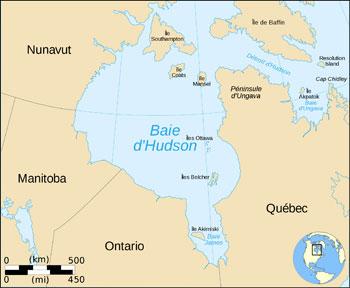
Wikimedia Commons
Greenland Bound
The Hudson Bay is a large body of water in northeastern Canada, and named after the explorer, Henry Hudson. Hudson Bay was the growth center for the main ice sheet that covered northern North America during the last Ice Age. The year round average temperature is -5 degrees, and water temperatures hover just below zero. The water is frozen from mid-December to mid-June. The western shores of the bay are known as the lowlands. The eastern coast has many islands groups, like the Belcher Islands and the Ottawa Islands. Hudson Bay is 470,000 square miles, making it the second-largest bay in the world. It is relatively shallow, with an average depth of about 330 ft. On the east it is connected to the Atlantic Ocean by the Hudson Strait, and on the north with the Arctic Ocean. Hudson Bay is sparsely populated with about a dozen villages. Some of these villages were founded in the 17th and 18th centuries by the Hudson's Bay Company as trading posts. In 1851, The American ship McLellan left a group of men behind to winter in Cumberland Sound. These were the first American whalers to deliberately winter in the Arctic, and the Inuit relationship with whalers began. In 1860, two American whale captains made a successful whaling trip into Hudson Bay, opening the door here to American whaling.
Whales were hunted up around Greenland decades before Hudson Bay was whaled. The song, "Greenland Bound" tells the story of whaling so far north, with short days and ice to contend with. To hear a clip of "Greenland Bound,", click on the "play music" button above.
JavaScript required access all features of this site. Use Browser Back to return.